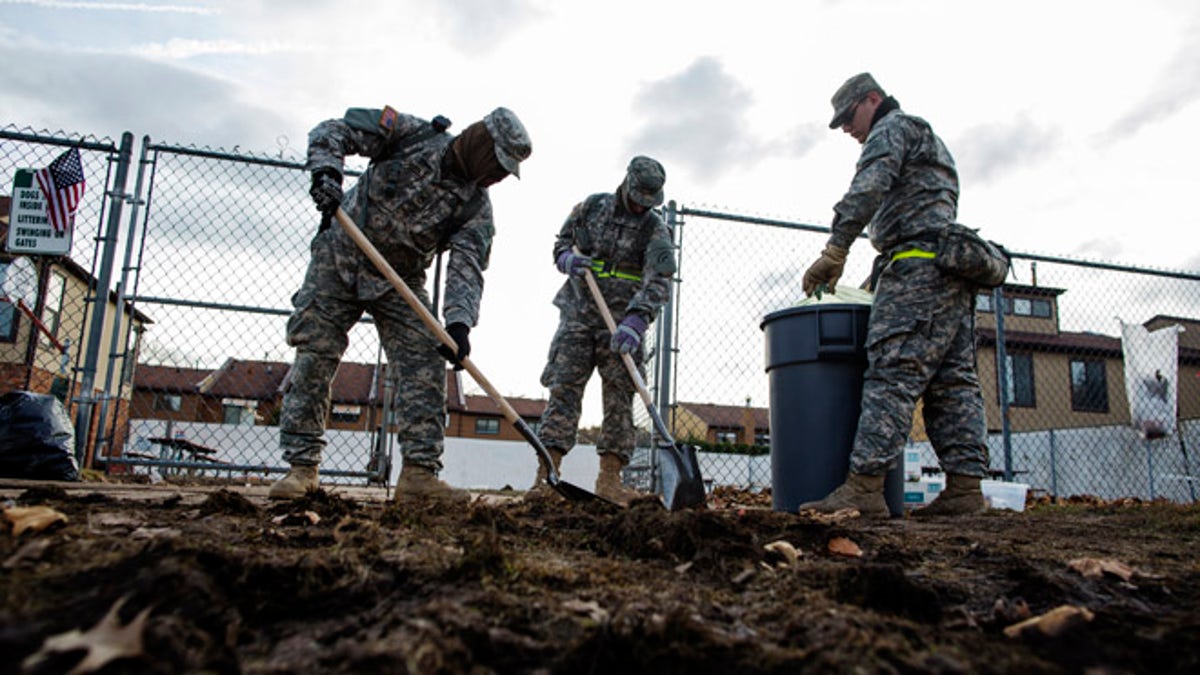
Nov. 15, 2012: National Guard troops work to clean sidewalks of storm debris from Hurricane Sandy in the Staten Island borough neighborhood of New Dorp Beach in New York. (Reuters)
America's governors disagree on a lot of issues. But they're united on one front -- stopping the Pentagon from proceeding with planned cuts to the Army National Guard.
As President Obama prepares to release his budget plan on Tuesday, all 50 governors have signed a letter asking him to keep the Guard's ranks at 350,000, instead of cutting it down to 335,000 as the Pentagon has suggested.
"The nation's governors strongly oppose the potential cuts," they wrote, after meeting with him and Defense Secretary Chuck Hagel during their annual winter meeting last week in Washington. "For more than a decade, our National Guard has demonstrated it is a cost-effective, operational force that is critical to our national security at home and abroad."
The concerns about National Guard cuts come on top of widespread concerns about the Pentagon's controversial plan to shrink the active-duty Army. As Republican and Democratic lawmakers prepare to challenge these and other cuts on Capitol Hill, the governors are taking an early stand over the National Guard.
They argued the cuts will reduce the Guard's ranks to pre-2001 levels -- reducing its capacity as an active combat force and ability to respond to natural disasters and emergencies, while acknowledging the country's "economic realities."
Critics of the proposed cuts point to 2012, when guardsmen rescued -- and delivered much-needed supplies to -- hundreds of New Jersey and New York residents hit by Superstorm Sandy.
"The rapid response of the National Guard was invaluable to helping our residents survive the storm," said New Jersey Assemblyman Joseph Egan, a Democrat. "They answered the call with exceptional coordination and management. Their continued involvement is integral in the rebuilding of our New Jersey."
If sequester cuts remain in place, the Guard's ranks could dwindle even further, to 315,000 in 2016.
The governors are also expressing concerns about potential cuts to the Air National Guard and are calling for a commission to study future personnel levels throughout the Army.
Such a commission would be similar to one South Carolina GOP Rep. Joe Wilson wants in a bill he's sponsoring that would also keep any cost-cutting efforts from reducing the Army National Guard strength below 350,000.
The National Guard force size varies significantly from state to state. The Defense Department determines the size of each state's National Guard unit based upon the needs of that state and the federal government. However, no change in the branch, organization or allotment of a unit entirely within a state can be made without the approval of its governor.
The governors signed the letter to Obama just days after they publicly squabbled on the White House lawn over the president's budget plan.
The proposed cuts to the Guard in fiscal 2015 are just part of the Pentagon's efforts to reconfigure itself for the future, including cutting the active Army from 520,000 to between 440,000 and 450,000 soldiers.
"We're coming out of the largest war we've ever been in," Hagel told CBS News this past weekend, referring to the fight in Afghanistan. "You reset your position based on the new realities ... and the challenges of the future."
But Sen. Rob Portman, R-Ohio, told "Fox News Sunday" he worries about cutting troop sizes amid the unrest in Ukraine, the Middle East and the South China Sea.
"It's a problem," Portman said.




